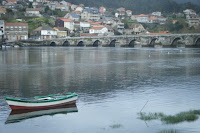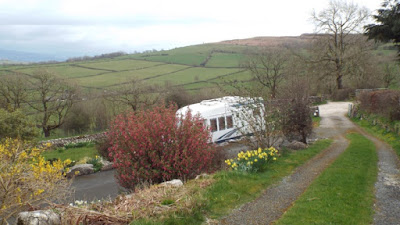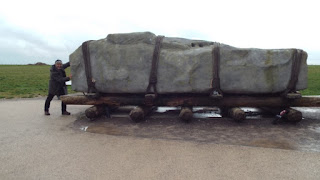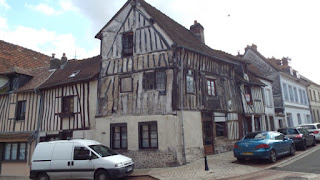 |
| Nazare Beach |
Our first year with no kids and no Easter Eggs! Not one! Someone forgot to let Easter Bunny know.
On reaching Comporta, we headed out to the resort sand spit with big beaches, scrubby sandy soil and big plantations of forestry, nothing like we have at home. This
 |
Bill always looking for a little bit of rope!
His pocket knife is a bit too litttle for this one :) |
amazing place has been well planned out as a resort, and although very empty while we walked the beach & drove through the streets, can imagine quite different come summer.
We had wanted to stop at Lisbon (Portugal's Capital) but the parking and traffic flow compelled us forever round the sea front (like Auckland's waterfront) so that when we finally stopped we were about 40 mins away and the traffic had been so difficult and we were so fragile, it was decided to keep on going, ending up in the small town of Mafra with a secured compound to spend the night and a supermarket & laundry 5 minutes away. Admittedly not with the cultural depth of Lisbon to draw on but still with a slice history not to be trifled
 |
| Mafra Palace |
with. On walk about the next morning in the main square was possibly the biggest palace to date for us, built for King John V who deigned to spend a few months in, more a secondary residence. All built with gold money that the Portuguese were extracting from Brazil, faster than the Royals could spend it!!!!!
The palace has a 92 bell carillon and is immense. We considered a tour but several hours of this (over 1200 rooms & 4700 doors and windows) would undoubtedly numb us, we had a nice cafe lunch (it wasn't very summery) instead and carried on up the west coast of Portugal
 |
| Wave action on Nazare Beach |
We came to Nazare & Siteo for 3 nights, a place we were told to visit and it was great. Its big draw cards are a fishing village come resort, situated on an internationally renowned surf beach. The Atlantic is a big ocean and is forever pounding the entire coast, grinding out stunning beaches and thrilling cliffs.
Nazare has the distinction of a world record height for a beach breaking wave surfed at 72 feet or 23m. The You Tubes of these waves are incredible and worth a watch. The surf seems to run continually but saw photos of much quieter benign beaches which is just as well as
 |
| Old Ladies selling their dried fish along Nazare |
you would not swim here often unless you were very competent. My dream of body surfing the beach was rapidly crushed as we witnessed the equally crushing waves, this was not for me, even if it had been another 20 degrees warmer.....
As we worked our way up in & out of coastal areas, we visited Aveiro, Portugal's Venice. It has, literally, a couple of canals into the town centre and is serviced by more boats than tourists at this time of year. Also in keeping with Venice it does have a large lagoon exploited traditionally for salt production and shell fish, sea food as always, a huge tourist draw. (the shellfish available is always huge from tiny pipi's and cockles up to
 |
Trailers loaded with nets
ready for the next day's fishing |
toheroa type bivalves mollusc's as well as winkles cats eyes etc. Mmmmmmm waiting for Sheryl's bro G'man when we join Claire and him for some time in France at the end of May, to shame us into being a bit more adventurous.......MMMMMMMMMMM!
Aviero was drizzly when we arrived in the late afternoon and it didn't look pleasant sitting in boats on the canal in the driving rain, so we walked the town and by the evening's end and had a Chinese meal (sweet & sour craving) with a lovely Portuguese beer & wine. As we had seen all the canals, we decided a boat trip was not warranted.
 |
| Churches faced up with blue tiles |
A characteristic of churches and notable old buildings through Portugal and northern Spain has been the blue painted tiles adorning both indoor and outdoor facades. They are from 14th Cent. and are indicative of the reclaiming by the Christians of the Peninsula from the Moors, not very old but still well outlasting frescoes and an insight into the accepted story of Christianity reigning at the time.
On reflection if asked about favourite places we would be recommending this coastline from southern Spain up thru Portugal, back into northern Spain and now across the Bay of Biscay. These areas are worth exploring we think, not so touristy,
 |
| Walk about Arcade's village |
possibly because the beaches are not as benign as the Mediterranean, and the climate not as settled. Still very acceptable from our point of view. It will be on our "get back if we can" list. Porto was a pleasant surprise, an old port town, though again wet, (we fluked a fine arrival for a 4 hour exploration ) but so scenic. The river is navigable for over 150 kms and a thriving tourist industry on big, ultra nice river boats from 6 to 15 days with various side trips going right into Spain.
Onto Vigo, but decided to carry on as the weather still wasn't great, and onto Arcade. A very pleasant village at the top of another inlet port, well removed from the industrious busy river mouth and existing on a small fishing industry, mainly the local shell fish. The town centre sculpture is a large pearl in an oyster so gives a hint of the promise.
 |
| One of the many "Horreo's" we saw in backyards |
We also started to observe family crypts in peoples back yards and once spotted, saw them all thru over the next few days and into Spain. We later found them to be what they call "Horreo's" - granaries, raised up of the ground on flat staddle stones to prevent rodents getting into them. Quite a quirky thing to see in many backyards in the towns and country alike.
 |
Gijion Beach across to Old Town
Bit of action for the surfers in the water. |
Gijon (Hehon) was another stop, a lovely seaside surf resort. Ticks all the boxes with retail cafes and across the road enough surf to keep Dad and the boys out of trouble and did I mention the cafes! We arrived in drizzle (a recurring theme as we head north) but the next morning the mountains behind us were liberally coated in snow. Just like Nelson can have in Spring too. The north here is very hilly. The towns are all located in ancient glacial/deep river valleys giving deep long sheltered access as fitting for maritime trade etc, shelter from the Atlantic storms, woe betide if you missed the harbour though.
 |
Wet weather doesn't put the
locals off coming to the beach |
Bilbao, an amazing campsite and arrived late with a WARM wind, so immediately sat overlooking the stunning vista and cracked a beer, planning our next day, only to awaken to driving rain and wind. A shame as it did look worth a look, boasts a Guggenheim gallery, though to be honest, modern objective art is not my strong point. Give me something I can tell what she is any day....... I know I'm a cultural pariah. So on we go, we will stop with the rain and see where we are.....
It was foolish of us to think spring would precede us, warming the Atlantic coast in preparation for such illustrious visitors such as ourselves as now on the cusp of
 |
Looking from Gijion's promenade back to the
snow covered mountains |
crossing into France, being dogged with very indifferent weather and much rain over the last few days we find ourselves now in the final throws of winter, with neither a palm or cactus to be found to remind us of our pleasant "wintering over in Southern Spain".....
The juxtaposition of the two ends of the Iberian Peninsular is so pronounced, gone are the Pueblo Blanco (white washed villages) and afore mentioned cactus, palms and still flowering bougainvilleas, we are now in deciduous forests, waterlogged and a few green buds of willow bravely peeking out
 |
| Bilboa - looking down on the town |
for a show. The farmland so hilly, looks more like Switzerland. Most people are well wrapped up, its only the mad Kiwi's still venturing out in shorts and light wind breakers.
 |
Our Bilboa campsite up on the hill.
But sadly was too wet the next day to explore. |































